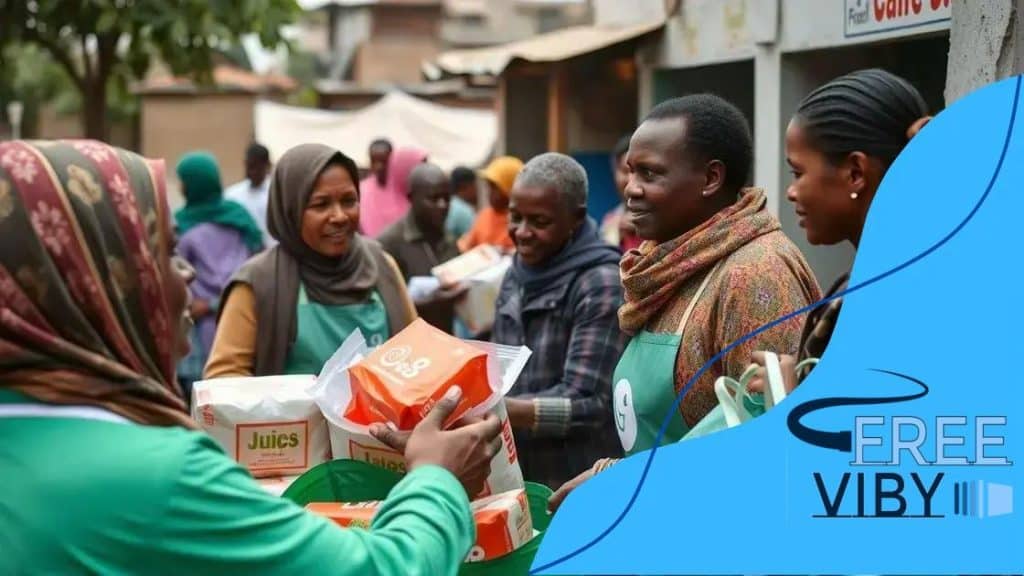Food aid funding shifts occur: What you need to know

Anúncios
Food aid funding shifts occur due to economic conditions, political factors, and community needs, prompting NGOs to adopt innovative strategies that prioritize sustainability and resilience in their programs.
Food aid funding shifts occur frequently, affecting how aid reaches those in need. Have you ever wondered what drives these changes and their consequences? Let’s dig deeper into this crucial topic.
Anúncios
Understanding food aid funding dynamics
Understanding food aid funding dynamics is crucial for grasping how humanitarian efforts can shift over time. This area is influenced by economic factors, policy decisions, and the needs of communities worldwide. Changes in funding can significantly impact the effectiveness of food aid programs.
Key Factors Influencing Funding
Several factors drive the dynamics of food aid funding. For one, the political climate in donor countries often determines the amount of money allocated for food assistance. Moreover, international emergencies can shift priorities and funding levels.
- Global crises affecting food supply
- Changes in government policies
- The role of non-governmental organizations
- Public perceptions of hunger and humanitarian needs
Additionally, economic conditions play a big role. When economies struggle, the funds available for aid can shrink, causing agencies to reevaluate their strategies. This means less money for critical assistance programs, highlighting the need for adaptable funding mechanisms.
Anúncios
The Role of Data in Funding Decisions
Access to accurate data is vital in understanding food aid funding dynamics. It allows organizations to allocate resources where they are needed most. Effective use of data analytics can inform decisions on where to send aid and how much is necessary. The reliance on data helps prevent waste and ensures that the most vulnerable populations receive help.
Monitoring and evaluation also play crucial roles in this dynamic. By tracking how funds are used and evaluating outcomes, organizations can better advocate for necessary changes in funding. When stakeholders see tangible results, they are more likely to support continued investment in food aid programs.
Recent trends in food aid allocations
Recent trends in food aid allocations reveal significant changes in how resources are distributed globally. Understanding these shifts can help us comprehend their impact on humanitarian efforts. Examining these trends gives insights into the priorities set by donor countries and organizations.
Shifts in Donor Priorities
In the past few years, donor priorities have changed dramatically. Many countries are focusing more on sustainable development rather than just immediate relief. This means resources are often directed toward projects that can help communities become self-sufficient.
- Increased funding for local farming initiatives
- Support for nutrition programs
- Investment in water and sanitation
- Focus on climate-resilient food systems
Alongside these shifts, there’s been a growing recognition of the importance of addressing the underlying causes of hunger. Donors are now more aware that simply providing food is not enough. They aim to enhance food security by tackling issues like poverty and education.
The Role of Technology in Allocations
Technology is playing a crucial role in modern food aid allocations. Data analytics and tracking tools help organizations measure the effectiveness of their aid. By leveraging technology, they can target assistance more accurately. This allows for better resource management, ensuring that aid reaches those who need it most.
Moreover, advancements in communication technologies have made it easier for agencies to coordinate efforts and share information. This transparency can boost donor confidence and encourage increased financial support for food aid programs.
Impacts on global hunger and malnutrition

The impacts on global hunger and malnutrition are deeply intertwined with changes in food aid funding. When funding shifts, vulnerable populations often face increased challenges. This relationship illustrates why understanding these funding dynamics is essential for addressing hunger.
Rising Hunger Levels
Recent trends indicate that rising hunger levels are a significant concern. When funding decreases or becomes more targeted, some areas may receive less support than needed, leading to higher hunger rates. In regions experiencing conflict or natural disasters, the situation can worsen even more.
- Increased food scarcity in conflict areas
- Higher rates of child malnutrition
- Economic instability leading to food insecurity
- Long-term health impacts from inadequate nutrition
Addressing these rising hunger levels requires concerted efforts from both governments and organizations. Enhanced collaboration can help divert resources to where they are needed most. Programs aimed at improving agricultural productivity can also lessen dependence on external aid.
Long-Term Effects of Malnutrition
Malnutrition has long-lasting effects on individual and community health. It can lead to stunted growth in children, affecting their development and education. Additionally, malnutrition increases susceptibility to diseases, creating a vicious cycle of health issues.
Current food aid strategies must adapt to focus not only on immediate relief but also on sustainable solutions. Investments in education about nutrition and food security are vital. By teaching communities about healthy eating and food production, the cycle of malnutrition can be broken.
The role of NGOs in adapting to funding changes
The role of NGOs in adapting to funding changes is crucial in the landscape of food aid. As funding shifts due to economic and political factors, these organizations must find new ways to respond effectively. Their flexibility and innovation often determine how well they can assist communities in need.
Adapting Strategies
NGOs have developed various strategies to adapt to changing funding scenarios. They frequently re-evaluate their programs to align with available resources. By doing so, they ensure that aid continues to reach those most in need, despite fluctuations in donor support.
- Exploring alternative funding sources
- Forming partnerships with local organizations
- Implementing cost-effective practices
- Enhancing technology to improve efficiencies
Many NGOs are also focusing on building strong relationships with their supporters. This engagement helps maintain and grow their funding base, even in uncertain times. By emphasizing transparency and communication, they can foster trust and collaboration with donors.
Diversifying Funding Sources
To mitigate risks associated with funding changes, NGOs have begun diversifying their funding sources. This includes seeking support from private sectors and exploring innovative funding models like crowdfunding. Such diversification can make organizations less vulnerable to fluctuations in government aid.
Moreover, these organizations actively participate in advocacy efforts, raising awareness about food insecurity. By highlighting the connection between funding and community well-being, they can mobilize additional support from various stakeholders.
Future outlook for food aid funding strategies
The future outlook for food aid funding strategies is evolving as the global landscape changes. As the demand for food assistance grows, organizations must adapt their approaches to secure necessary resources. Understanding these emerging trends is essential for effective aid delivery.
Emergence of Innovative Funding Models
Innovative funding models are becoming more prevalent in food aid strategies. Traditional funding methods are being supplemented by new models that appeal to donors looking for greater impact. These may include social impact bonds, which connect funding to measurable outcomes.
- Collaboration with private sector stakeholders
- Use of technology for crowdfunding campaigns
- Investing in impact investment opportunities
- Engaging in public-private partnerships
As organizations explore these options, they can create a more sustainable funding environment. Such strategies not only diversify funding sources but also promote accountability and transparency.
Focus on Sustainability and Resilience
Looking ahead, there is a strong focus on sustainability and resilience in food aid funding. Organizations are shifting their strategies to include long-term solutions that help communities thrive rather than just survive. This focus on sustainability can alleviate dependency on ongoing aid.
Programs that invest in agricultural development, education, and nutrition can enhance local resilience. By empowering communities to grow their own food and improve their nutritional knowledge, the cycle of food insecurity can be broken.
FAQ – Frequently Asked Questions about Food Aid Funding Strategies
What are the main factors affecting food aid funding changes?
Economic conditions, government policies, and global emergencies significantly influence how food aid funding is allocated.
How can NGOs adapt to shifts in funding?
NGOs can adapt by exploring alternative funding sources, forming partnerships, and implementing cost-effective practices.
Why is sustainability important in food aid programs?
Sustainability helps communities become self-sufficient, reducing dependency on aid and ensuring long-term food security.
What role does technology play in modern food aid strategies?
Technology is crucial for data analytics, enabling organizations to measure effectiveness and target assistance more accurately.






